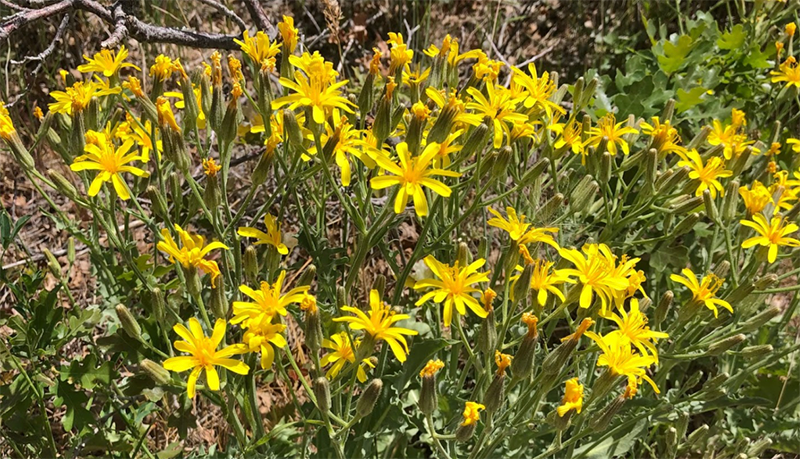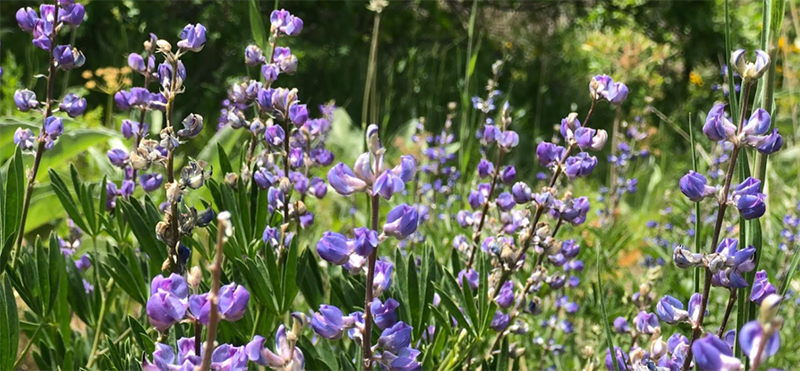Take a walk in the foothills above the Natural History Museum of Utah in early June and you will find that it is absolutely carpeted with wildflowers in an array of gorgeous hues. What follows is a list of some of the more common ones you will encounter. Get outside and see how many you can find!
Reposted from the museum blog.
1. Boreal Sweetvetch (Hedysarum boreale)

PHOTO CREDIT: Allison Izaksonas/©NHMU
Boreal Sweetvetch (Hedysarum boreale)
This is a hard-to-miss bright pink member of the pea family. Apart from its showy color, you can tell it by its distinctive pea flower shape (banner, wings and keel as seen here) and its leaf shape, which is pinnately compound (many leaflets situated on opposite sides of a central stalk).
2. Tapertip Hawksbeard (Crepis acuminata)

PHOTO CREDIT: Allison Izaksonas/©NHMU
Tapertip Hawksbeard (Crepis acuminata)
The leaves really give this one away! If you didn’t know better, you might mistake it as a dandelion on steroids with extremely toothy leaves and its yellow aster-like flowers. But unlike dandelion, the leaves are grey-green and leathery and there are several flowers on each stalk.
3. Mulesear (Wyethia amplexicaulis)

PHOTO CREDIT: Allison Izaksonas/©NHMU
Mulesear (Wyethia amplexicaulis)
Download Full-Res Image
It’s easy to mistake this flower for the spring-blooming foothills resident, arrowleaf balsamroot. They both have large yellow aster-like flowers and grow close to the ground (unlike the tall stalk of sunflower). Additionally, there is some overlap in flowering times. In order to tell them apart, look at the leaves. Mulesear will have dark green lance-shaped leaves, while balsamroot has heart-shaped leathery, grey-green leaves.
4. Sego Lily (Calochortus nuttallii)

PHOTO CREDIT: Allison Izaksonas/©NHMU
Sego Lily (Calochortus nuttallii)
Download Full-Res Image
How could I not mention our iconic state flower? Don’t miss out on seeing this in person. Sego lily is unmistakable with its three large white petals that are yellow and hairy at the base.
5. Wasatch Penstemon (Penstemon cyananthus)

PHOTO CREDIT: Allison Izaksonas/©NHMU
Wasatch Penstemon (Penstemon cyananthus)
In my opinion, Wasatch penstemon is one of the most iconic wildflowers of our area. It is tall with unearthly blue-violet flowers. The leaves are situated opposite of one another and have wide bases that appear to clasp the stem. Despite its name, this plant is found throughout the U.S. Rockies.
8. Silvery Lupine (Lupinus argenteus)

PHOTO CREDIT: Allison Izaksonas/©NHMU
Silvery Lupine (Lupinus argenteus)
Download Full-Res Image
Lupines are distinguished by their tall spikes of flowers and their leaves which are palmately compound (the 5-9 leaflets are situated radially around a central point, like outstretched fingers on the palm of your hand.) This plant has blue-purple flowers in a typical pea flower shape like sweetvetch.
